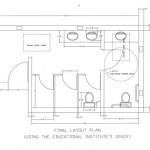What to Put Under Laminate Flooring in a Bathroom
Laminate flooring, with its durability, water resistance, and style, can be an excellent choice for a bathroom floor. However, installing laminate flooring in a bathroom requires careful consideration of the subfloor preparation. The bathroom's unique moisture environment necessitates a specific approach to ensure the flooring's longevity and prevent problems like warping, buckling, and mold growth.
Installing laminate flooring in a bathroom is different from other rooms because of the potential for moisture exposure. It's crucial to understand the specific considerations involved in bathroom subfloor preparation to ensure a successful and long-lasting installation.
Understanding Subfloor Preparation for Laminate Flooring in Bathrooms
Before installing laminate flooring, you need to create a solid, even, and moisture-resistant base. Here's a breakdown of the essential steps:
1.
Inspecting the Existing Subfloor:
Assess the condition of the subfloor for any signs of rot, damage, or unevenness. If necessary, repair or replace damaged sections, making sure the surface is level for a smooth, even installation.2.
Moisture Barrier:
A crucial step in bathroom laminate flooring installation is creating a moisture barrier. This prevents moisture from penetrating the subfloor and damaging the laminate. There are several options for moisture barriers:- Plastic Sheeting: A cost-effective choice, plastic sheeting should overlap by at least 6 inches and be taped at the seams to create a sealed barrier.
- Moisture-Resistant Underlayment: Specialized underlayment products designed specifically for bathrooms offer superior moisture resistance and sound dampening while providing a cushioned base for the laminate.
- Vapor Barrier: This type of underlayment acts as a moisture barrier while also providing a layer of cushioning for the laminate.
3.
Leveling the Subfloor:
If the subfloor is uneven, you'll need to level it before installing the laminate. This can be done with self-leveling compound or shims. A level subfloor ensures a stable and aesthetically pleasing installation.Key Considerations for Bathroom Laminate Flooring
Here are some key factors to consider when planning your bathroom laminate flooring installation:
1. Water Resistance
Choose laminate flooring specifically designed for wet areas. These products have a higher level of water resistance, often featuring a moisture-resistant core and a sealed edge. Look for flooring with a water resistance rating from the manufacturer.
2. Underlayment
Selecting the right underlayment is crucial for managing moisture and providing a comfortable surface. Choose a moisture-resistant underlayment specifically designed for bathrooms. Look for features such as:
- Moisture Barrier: Prevents moisture from reaching the subfloor and the laminate.
- Water-Resistant Core: Ensures the underlayment itself can withstand moisture exposure.
- Vapor Barrier: Helps prevent moisture from transferring through the floor.
3. Proper Installation
Proper installation is essential for the longevity of your laminate flooring. Here are some tips for a successful installation:
- Follow Manufacturer Instructions: Always adhere to the manufacturer's instructions for installation. These instructions will provide specific guidelines for your chosen laminate flooring type and underlayment.
- Use a Moisture Meter: Before installation, use a moisture meter to ensure the subfloor is adequately dry. This will help prevent premature failure.
- Leave Expansion Gaps: Laminate flooring expands and contracts with changes in temperature and humidity. Leave an expansion gap of about 1/4 inch around the perimeter of the room and between planks to accommodate this movement.
- Seal Gaps: After installation, seal any gaps between the laminate boards and the walls using a moisture-resistant caulk.
4. Regular Maintenance
Maintaining your laminate flooring will help it remain in good condition. Follow these maintenance tips:
- Clean Regularly: Sweep or vacuum the floor regularly to remove dirt and debris that could scratch the surface.
- Use a Damp Mop: For occasional cleaning, use a damp mop with a mild cleaning solution. Avoid excessive water.
- Address Spills Promptly: If a spill occurs, wipe it up immediately to prevent water damage.
By carefully considering all these factors and following best practices, you can enjoy the benefits of laminate flooring in your bathroom for years to come.

How To Install Waterproof Laminate Flooring Twenty Oak

How To Install Vinyl Plank Flooring In A Bathroom Fixthisbuildthat

Choosing Laminate Flooring For Your Bathroom Tarkett Asia

Does Laminate Make The Best Bathroom Flooring Carpet Guys

Vinyl Planks In Bathrooms Residential Inspiration Flooring

Can You Put Laminate Floors Under Around Vanity Toilet Tub Ready To Diy

What Is A Moisture Barrier And When It Needed For Flooring Inc

The Best Way To Install Laminate Flooring In Bathroom Pro

Laminate Flooring In Bathrooms Important Pros And Cons 21oak

Best Bathroom Flooring
Related Posts







